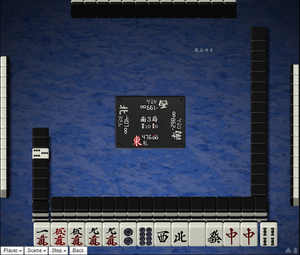Honba

Honba 「本場」 or tsumibou count is an added element to scoring, that awards bonus points for particular repeats. The honba count increases by one for the next hand according to these three scenarios:
- Exhaustive draw
- Abortive draw
- Dealer winning the hand
When any non-dealer wins a hand, then the honba count resets back down to zero.
This count increases hand values by a total of 300 per honba. For ron, the discarder pays the additional 300 points. For tsumo, everyone pays an additional 100 each. These extra points are added to the hand value after the capping as mangan, haneman, etc., so a non-dealer mangan tsumo with 2 honba costs 2,200 for a non-dealer and 4,200 for the dealer. In the case of sekinin barai, the yakuman tsumo payment is borne entirely by the discarder of the ponned tile, who also has to pay 300 per honba. On a ron, the yakuman value is split between the discarder of the winning tile and the discarder of the earlier ponned tile. Most rules have the winning tile discarder pay for all honba.
For online play, the honba count is automatically noted. However, with real tiles, the current dealer indicates the honba count by using 100-point sticks and placing them on the dealer indicator or on the table. These 100-point sticks are merely counters. If ryuukyoku occurs where the dealer is not tenpai, then the wind seating rotates and the honba count increases by one. For any time the wind seating rotates, the 100-point sticks are returned to the dealer; and the next dealer assumes responsibility of tracking the honba count.
A custom rule named basengo 「場千五」 may be used, by which the honba value is five times the normal value. With this rule, instead of 300 points per honba, it is 1500 points per honba. This rule is not commonly used; and instead, it can be found under gambling situations.
External links
- Honba in Japanese Wikipedia